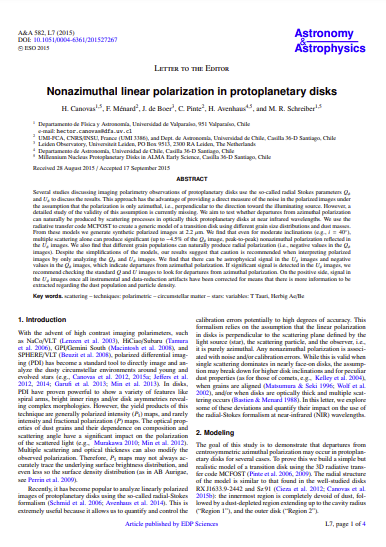Nonazimuthal linear polarization in protoplanetary disks
Licencia: Creative Commons (by-nc-nd)
Autor(es): Canovas, H; [et al.]
Several studies discussing imaging polarimetry observations of protoplanetary disks use the so-called radial Stokes parameters Q and U to discuss the results. This approach has the advantage of providing a direct measure of the noise in the polarized images under the assumption that the polarization is only azimuthal, i.e., perpendicular to the direction toward the illuminating source. However, a detailed study of the validity of this assumption is currently missing. We aim to test whether departures from azimuthal polarization can naturally be produced by scattering processes in optically thick protoplanetary disks at near infrared wavelengths. We use the radiative transfer code MCFOST to create a generic model of a transition disk using di erent grain size distributions and dust masses. From these models we generate synthetic polarized images at 2:2 m. We find that even for moderate inclinations (e.g., i = 40 ), multiple scattering alone can produce significant (up to 4:5% of the Q image, peak-to-peak) nonazimuthal polarization reflected in the U images. We also find that di erent grain populations can naturally produce radial polarization (i.e., negative values in the Q images). Despite the simplifications of the models, our results suggest that caution is recommended when interpreting polarized images by only analyzing the Q and U images. We find that there can be astrophysical signal in the U images and negative values in the Q images, which indicate departures from azimuthal polarization. If significant signal is detected in the U images, we recommend checking the standard Q and U images to look for departures from azimuthal polarization. On the positive side, signal in the U images once all instrumental and data-reduction artifacts have been corrected for means that there is more information to be extracted regarding the dust population and particle densi.
[2015]
Compartir:
Una vez que el usuario haya visto al menos un documento, este fragmento será visible.


